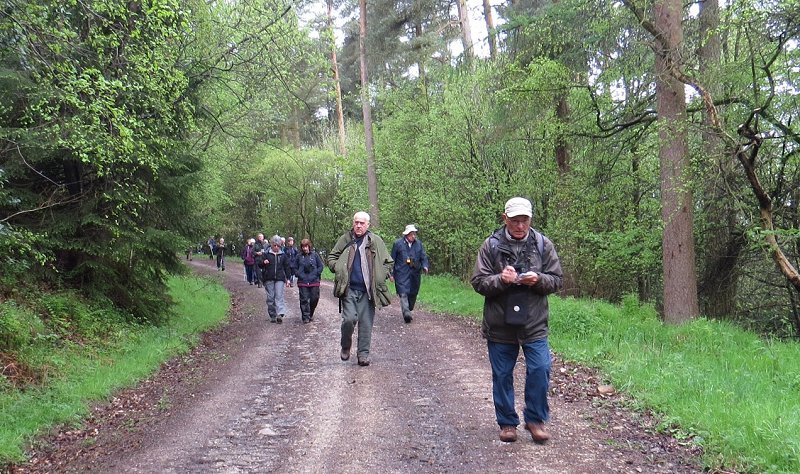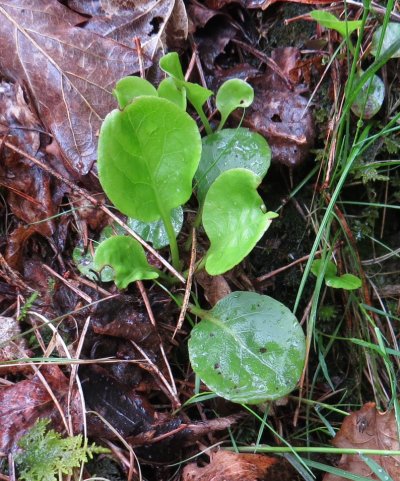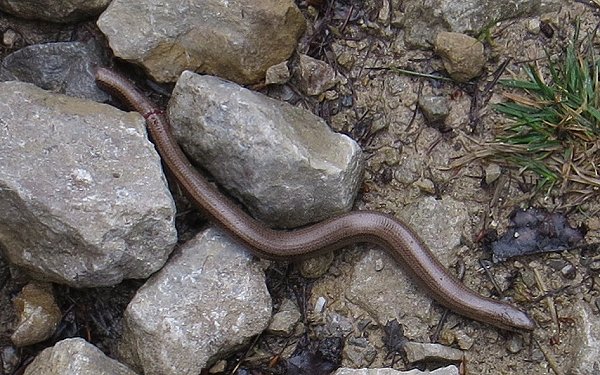
Back to the Home page
Species lists below
We met at Stape village hall for our 50th Anniversary meeting to retrace the steps of those founder members through Raindale and to try and find the rarer plants that they discovered all those years ago. We were delighted to welcome members from the C.M. Rob Society, Cleveland Field Naturalists and Whitby Field Naturalists. We were particularly pleased with the presence of Gordon Simpson, one of our founder members and the leader on that first event 50 years ago. A group of 28 of us set off in our full wet weather gear. Hats off to all of us for braving a weather forecast of prolonged heavy downpours. However, despite some rain it was to be a glorious afternoon with sunshine at times.

Our intention was to walk at a pace through Raindale to the railway line in Newtondale and then botanise in detail on the way back with members also recording other wildlife. However, it just proved too tempting for some and the pace was slow out and snail pace on return. But the rewards were rich. Gordon knew what was high on his list, Intermediate wintergreen Pyrola media. He didn’t waste any time finding it, he remembered the marker and went straight to it. There it was, about three metres off the path just under the trees, on the same small hump from 50 years ago.
 He admitted that the last time he visited it was in 1970. Well remembered Gordon! It was too early to be in flower and it will be revisited at a later date. [Ed: a later visit in June showed four clumps of Pyrola on the same mound, and on the opposite side of the track were four plants of pepper saxifrage with loads of ragged robin in flower nearby too. Lesser spearwort was seen in the ditch, and plenty of yellow rattle and common spotted orchids in abundance.]
He admitted that the last time he visited it was in 1970. Well remembered Gordon! It was too early to be in flower and it will be revisited at a later date. [Ed: a later visit in June showed four clumps of Pyrola on the same mound, and on the opposite side of the track were four plants of pepper saxifrage with loads of ragged robin in flower nearby too. Lesser spearwort was seen in the ditch, and plenty of yellow rattle and common spotted orchids in abundance.]
What was also of interest were the three types of horsetail Equisetum, Wood E. sylvaticum, Marsh E. palustreM, and Great E. telmateia, with the latter dwarfing the other two significantly. Again, it will be a few more weeks before they are fully on show.
Some of the species on the original list were not found and we learned that they were further a field than our walk was taking us so we did not pursue them. A total of 169 plants were found which is quite impressive but there will be others later in the growing season.
We recorded a total of 33 birds on the walk with all the anticipated summer visitors present. In Newtondale we watched a House Martin Delichon urbica building a nest under the eaves of the old railway cottages and close by on Pickering Beck a Grey Wagtail Motacilla cinerea was seen feeding young. High overhead were 10 or more Swifts Apus apus that had recently arrived. A few lucky members were treated to the sight of a Dipper Cinclus cinclus in the lower reaches of Raindale Beck. Insects were not in abundance, perhaps due to the inclement weather, and unsurprisingly for the time of year only a small number of fungi were noted. All the species found on the day were to be placed on the Society’s records.
 We were able to study the activity of a slow worm Anguis fragilis, unfortunately damaged by one of us accidentally standing on it. It shed its tail very quickly as we know it can do but what was remarkable was the consequent activity of the tail. It was about 10cm long and continued to move rapidly despite being totally independent. It even coiled itself round a finger with some amount of pressure being exercised. We monitored it and it continued to move for about 10 minutes although with diminishing effort. We concluded that its nervous system must operate like this as a defensive mechanism, deflecting the predator’s attention from the main body of the slow worm to the shedded tail.
We were able to study the activity of a slow worm Anguis fragilis, unfortunately damaged by one of us accidentally standing on it. It shed its tail very quickly as we know it can do but what was remarkable was the consequent activity of the tail. It was about 10cm long and continued to move rapidly despite being totally independent. It even coiled itself round a finger with some amount of pressure being exercised. We monitored it and it continued to move for about 10 minutes although with diminishing effort. We concluded that its nervous system must operate like this as a defensive mechanism, deflecting the predator’s attention from the main body of the slow worm to the shedded tail.
On returning to Stape village hall we enjoyed tea and home-made cake. We had a short discussion on species found and were entertained by Gordon giving us a short talk on how things have changed here in Raindale from 50 years ago.
A thoroughly enjoyable afternoon and thanks go to all those who contributed to this special meeting from outside the Society and from those within. Thanks also go to Darlington and Teesside Naturalists' Field Club and Cleveland Naturalists' Field Club for sending congratulatory cards.
|
|
| Latin name | English name |
|---|---|
| Acer pseudoplatanus | Sycamore |
| Achillea millefolium | Yarrow |
| Ajuga reptans | Bugle |
| Alchemilla xanthochlora | Lady's mantle |
| Alliaria petiolata | Hedge garlic or Garlic mustard |
| Allium ursinum | Ramsons |
| Alnus glutinosa | Alder |
| Anemone nemorosa | Wood anemone |
| Angelica sylvestris | Angelica |
| Anthoxanthum odoratum | Sweet vernal grass |
| Anthriscus sylvestris | Cow parsley |
| Arrhenatherum elatius | False oat |
| Artemesia vulgaris | Mugwort |
| Athyrium filix-femina | Lady fern |
| Bellis perennis | Daisy |
| Betula pendula × pubescens (B. × aurata) | Hybrid birch |
| Betula pubescens | Downy birch |
| Blechnum spicant | Hard fern |
| Brachypodium sylvaticum | Slender false brome |
| Calluna vulgaris | Ling |
| Caltha palustris | Marsh marigold |
| Capsella bursa-pastoris | Shepherd's purse |
| Cardamine flexuosa | Wavy bittercress |
| Cardamine hirsuta | Hairy bittercress |
| Carex flacca | Glaucous sedge |
| Carex nigra | Common sedge |
| Carex remota | Remote sedge |
| Carex sylvatica | Wood sedge |
| Centaurea nigra | Common knapweed |
| Cerastium fontanum | Common mouse-ear |
| Cerastium glomeratum | Sticky mouse-ear |
| Chamaenerion angustifolium | Fireweed or Rosebay Willowherb |
| Chrysosplenium oppositifolium | Opposite-leaved golden saxifrage |
| Cirsium arvense | Creeping thistle |
| Cirsium palustre | Marsh thistle |
| Conopodium majus | Pignut |
| Corylus avellana | Hazel |
| Crataegus monogyna | Hawthorn |
| Cruciata laevipes | Crosswort |
| Cytisus scoparius | Broom |
| Dactylis glomerata | Cocksfoot |
| Dactylorhiza fuchsii | Common spotted orchid |
| Deschampsia caespitosa | Tufted hair grass |
| Digitalis purpurea | Foxglove |
| Dryopteris affinis | Golden-scaled male fern |
| Dryopteris dilatata | Common buckler fern |
| Dryopteris filix-mas | Male fern |
| Epilobium montanum | Broad-leaved willowherb |
| Equisetum palustre | Marsh horsetail |
| Equisetum sylvaticum | Wood horsetail |
| Equisetum telmateia | Giant horsetail |
| Eranthis hyemalis | Winter aconite |
| Erica cinerea | Bell heather |
| Eupatorium cannabinum | Hemp agrimony |
| Fagus sylvatica | Beech |
| Festuca rubra | Red fescue |
| Filipendula ulmaria | Meadowsweet |
| Fragaria vesca | Wild strawberry |
| Fraxinus excelsior | Ash |
| Galanthus nivalis | Snowdrop (garden escape) |
| Galium aparine | Cleavers |
| Galium palustre | Marsh bedstraw |
| Galium saxatile | Heath bedstraw |
| Geranium robertianum | Herb Robert |
| Geum rivale | Water avens |
| Hedera helix | Ivy |
| Heracleum sphondylium | Hogweed |
| Holcus mollis | Creeping soft grass* |
| Hyacinthoides non-scripta | Bluebell |
| Hypericum perforatum | Perforate St Johnswort |
| Hypericum tetrapterum | Square-stalked St Johnswort |
| Hypochaeris radicata | Catsear |
| Ilex aquifolium | Holly |
| Juncus articulatus | Jointed rush |
| Juncus effusus | Soft rush |
| Juncus inflexus | Hard rush |
| Juncus subnodulosus | Blunt-flowered rush* |
| Lamiastrum galeobdolon ssp. argentatum | Yellow archangel (garden escape) |
| Lamium album | White dead nettle |
| Lapsana communis | Nipplewort |
| Larix sp. (L. decidua) | Larch |
| Lathyrus linifolius | Bitter vetch |
| Lathyrus pratensis | Meadow vetchling |
| Leucanthemum vulgare | Dog daisy or Ox-eye daisy |
| Lotus corniculatus | Common birdsfoot trefoil |
| Lotus pedunculatus | Greater birdsfoot trefoil |
| Luzula campestris | Field woodrush |
| Luzula multiflora | Heath woodrush |
| Luzula sylvatica | Greater woodrush |
| Lysimachia nemorum | Yellow pimpernel |
| Malus sylvestris | Crab apple |
| Matricaria discoidea | Pineapple weed |
| Meconopsis cambrica | Welsh poppy |
| Mentha aquatica | Water mint |
| Mercurialis perennis | Dog's mercury |
| Molinia caerulea | Purple moor grass |
| Mycelis muralis | Wall lettuce |
| Myosotis sylvatica | Wood forgetmenot |
| Orchis mascula | Early purple orchid |
| Oxalis acetosella | Wood sorrel |
| Picea abies | Norway spruce |
| Pinus sylvestris | Scots pine |
| Plantago lanceolata | Ribwort plantain |
| Plantago major | Ratstail plantain |
| Polygala serpyllifolia | Heath milkwort |
| Polygonatum multiflorum x odoratum (P. x hybridum) | Garden Solomon's seal |
| Potentilla anserina | Silverweed |
| Potentilla erecta | Tormentil |
| Potentilla reptans | Creeping cinquefoil |
| Potentilla sterilis | Barren strawberry |
| Primula vulgaris | Primrose |
| Prunella vulgaris | Self heal |
| Prunus padus | Bird cherry |
| Prunus spinosa | Blackthorn |
| Pteridium aquilinum | Bracken |
| Pulmonaria officinalis | Lungwort (garden escape) |
| Pyrola media | Intermediate wintergreen |
| Quercus sp. | Oak |
| Ranunculus acris | Meadow buttercup |
| Ranunculus bulbosus | Bulbous buttercup |
| Ranunculus ficaria = Ficaria verna ssp fertilis | Lesser celandine |
| Ranunculus flammula | Lesser spearwort |
| Ranunculus repens | Creeping buttercup |
| Rhinanthus minor | Yellow rattle |
| Ribes uva-crispa | Gooseberry |
| Rosa arvensis | Field rose |
| Rosa canina | Dog rose |
| Rosa mollis | Downy rose |
| Rubus caesius | Dewberry |
| Rubus fruticosus | Bramble |
| Rubus idaeus | Raspberry |
| Rumex acetosa | Common sorrel |
| Rumex obtusifolius | Broad-leaved dock |
| Rumex sanguineus | Wood dock |
| Salix caprea | Goat willow |
| Salix cinerea | Grey willow |
| Salix repens | Creeping willow |
| Sambucus nigra | Elder |
| Sanguisorba minor = Poterium sanguisorba | Salad burnet* |
| Senecio jacobea | Common ragwort |
| Saxifraga x urbium | London pride (garden escape) |
| Senecio vulgaris | Common groundsel |
| Silene dioica | Red campion |
| Sorbus aucuparia | Rowan |
| Stachys officinalis = Betonica officinalis | Betony |
| Stachys sylvatica | Hedge woundwort |
| Stellaria alsine | Bog stitchwort |
| Stellaria holostea | Greater stitchwort |
| Stellaria media | Chickweed |
| Succisa pratensis | Devilsbit scabious |
| Symphoricarpos albus | Snowberry (garden escape) |
| Taraxacum sp. | Dandelion |
| Trifolium medium | Zigzag clover |
| Trifolium pratense | Red clover |
| Trifolium repens | White clover |
| Tsuga heterophylla | Western hemlock* |
| Typha latifolia | Common reedmace |
| Tussilago farfara | Coltsfoot |
| Ulex europaeus | Gorse |
| Urtica dioica | Nettle |
| Vaccinium myrtillus | Bilberry |
| Valeriana dioica | Marsh valerian |
| Valeriana officinalis | Common valerian |
| Veronica chamaedrys | Germander speedwell |
| Veronica serpyllifolia | Thyme-leaved speedwell |
| Viburnum opulus | Guelder rose |
| Vicia sepium | Bush vetch |
| Viola palustris | Marsh violet |
| Viola reichenbachiana | Early dog violet |
| Viola riviniana | Dog violet |
* probable id
170 spp. including garden escapes and trees.
The wintergreen is assigned to P. media as Gordon has seen it here in flower. The burnet might have been very young leaves of Greater burnet.
Mosses
Rhytidiadelphus squarrosus - “Springy Turf-moss”
Rhytidiadelphus loreus - “Little Shaggy-moss”
Hylocomium splendens - “Glittering Wood-moss”
We also saw a slow-worm, a frog, a newt, green-veined white and orange tip butterflies, wood ants and a wolf spider.
| © Ryedale Natural History Society 2014, Photos © Jayne Smith 2014 |